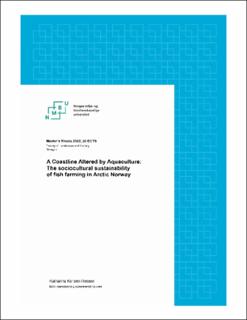| dc.description.abstract | Aquaculture is the fastest growing food production sector in the world, and Norway is this sector’s largest producer of farmed salmon. More than one thousand fish farms are spread along the Norwegian coastline, producing more than one million tonnes of farmed fish per year. The industry is controversial, due to its environmental impacts, its tendency to generate massive private profits, and its impacts on traditional coastal activities such as fisheries and recreation. In spite of this controversy, the Norwegian government has determined that the industry should aim for a quintupling in its production volume by 2050. In order to ensure that this growth is sustainable, an indicator-based system (the Traffic Light System) was put in place in 2017. This system uses salmon lice levels as the sole indicator of sustainability, and areas where lice levels are considered acceptable are incentivized to grow by several percentage points each year. Critics argue that this system does not address the myriad other environmental issues that the aquaculture industry struggles with, such as emissions, pollution, genetic impacts on wild species and animal welfare. Others argue that the industry has impacts beyond the environmental dimension, and that the economic and social dimensions of sustainability need to be addressed in the governance of the industry.
This study examines the perceived social and cultural sustainability of the aquaculture industry in two Arctic Norwegian communities, and applies these qualitative findings to the creation of a framework to identify and measure sociocultural sustainability in aquaculture operations, using Sustainability Indicators. The framework consists of a barometer with principles and indicators for sociocultural sustainability, as well as a visual | en_US |

